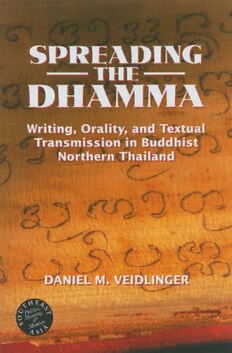
Spreading the Dhamma: Writing, Orality, And Textual Transmission in Buddhist Northern Thailand (Southeast Asia--Politics, Meaning, Memory) PDF
281 Pages·2006·2.681 MB·English
Most books are stored in the elastic cloud where traffic is expensive. For this reason, we have a limit on daily download.
Preview Spreading the Dhamma: Writing, Orality, And Textual Transmission in Buddhist Northern Thailand (Southeast Asia--Politics, Meaning, Memory)
Description:
How did early Buddhists actually encounter the seminal texts of their religion? What were the attitudes held by monks and laypeople toward the written and oral Pali traditions? In this pioneering work, Daniel Veidlinger explores these questions in the context of the northern Thai kingdom of Lan Na. Drawing on a vast array of sources, including indigenous chronicles, reports by foreign visitors, inscriptions, and palm-leaf manuscripts, he traces the role of written Buddhist texts in the predominantly oral milieu of northern Thailand from the fifteenth to the nineteenth centuries.Veidlinger examines how the written word was assimilated into existing Buddhist and monastic practice in the region, considering the use of manuscripts for textual study and recitation as well as the place of writing in the cultic and ritual life of the faithful. He shows how manuscripts fit into the economy, describes how they were made and stored, and highlights the understudied issue of the "cult of the book" in Therav?da Buddhism. Looking at the wider Therav?da world, Veidlinger argues that manuscripts in Burma and Sri Lanka played a more central role in the preservation and dissemination of Buddhist texts.By offering a detailed examination of the motivations driving those who sponsored manuscript production, this study draws attention to the vital role played by forest-dwelling monastic orders introduced from Sri Lanka in the development of Lan Na’s written Pali heritage. It also considers the rivalry between those monks who wished to preserve the older oral tradition and monks, rulers, and laypeople who supported the expansion of the new medium of writing. Throughout the book, Veidlinger emphasizes the influence of changing modes of communication on social and intellectual life. The medium, he argues, is deeply involved in the assimilation of the content, and therefore the vessels by which texts have been transmitted in the Buddhist world should not be ignored. Spreading the Dhamma constitutes an important addition to the fields of Southeast Asian studies, Buddhist studies, and the history of communications and sets up a model of textual transmission that has implications for the study of Buddhism and religion in traditional societies in general.
See more
The list of books you might like
Most books are stored in the elastic cloud where traffic is expensive. For this reason, we have a limit on daily download.
